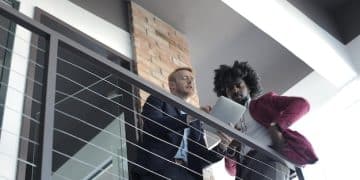The Ultimate Guide to Conference Networking: Maximize Your Impact

Networking at conferences can significantly boost your career or business; this ultimate guide provides actionable strategies to maximize your time, make lasting impressions, and build valuable relationships, ensuring you stand out from the crowd and achieve your networking goals.
Attending conferences is a great way to learn about new trends and technologies in your field, but one of the most valuable aspects of these events is the opportunity to network. This ultimate guide to networking at conferences: maximize your time and make lasting impressions, will provide you with the strategies you need to make the most of these opportunities, build meaningful connections, and advance your career or business.
Why Networking at Conferences Matters
Networking at conferences goes beyond simply collecting business cards. It’s about building genuine relationships that can lead to collaborations, new opportunities, and career advancements. But why is it so important, and what makes it different from other forms of networking?
Conferences offer a unique environment where professionals from various backgrounds and industries converge. This creates a melting pot of ideas, experiences, and perspectives, making it an ideal place to forge meaningful connections. Here’s a closer look at the significance of conference networking:
Expanding Your Professional Circle
Conferences provide a concentrated opportunity to meet people you wouldn’t normally encounter in your day-to-day work. You can expand your professional circle significantly by connecting with individuals who share your interests and goals.
Gaining New Insights and Perspectives
Talking to people from different backgrounds at conferences can expose you to new ideas and ways of thinking. This can broaden your understanding of your industry and help you develop innovative solutions to problems.
- Meet potential mentors and advisors who can guide your career.
- Find collaborators for future projects and partnerships.
- Discover new job opportunities.
- Gain insights into industry trends and best practices.
Networking at conferences can be a game-changer for your career or business. By understanding its importance and adopting effective strategies, you can unlock new opportunities and build lasting relationships. Remember, it’s not just about who you know, but who knows you.

Preparing for Conference Networking
Effective networking at conferences requires preparation. You can’t simply show up and expect meaningful connections to happen. Advance planning is key. Let’s break down the essential steps you should take before attending the event.
Preparation sets the stage for successful interactions and ensures you make the most of your time. It’s not just about having a polished elevator pitch; it’s about understanding your goals and knowing how to approach networking opportunities. Here’s how to prepare effectively:
Setting Clear Goals
Before you even pack your bags, determine what you want to achieve at the conference. Are you looking for new clients, potential partners, or career advice? Knowing your objectives will help you focus your networking efforts.
Researching Attendees and Speakers
Most conferences provide a list of attendees and speakers. Take the time to review this list and identify individuals you’d like to meet. Research their backgrounds and interests to prepare relevant conversation starters.
- Create a list of target attendees and speakers.
- Research their backgrounds and interests.
- Draft personalized conversation starters.
- Set realistic networking goals.
By taking the time to prepare, you can approach conference networking with confidence and purpose. Remember, effective networking is about quality over quantity. It’s better to make a few meaningful connections than collect dozens of business cards.
Making a Great First Impression
First impressions are crucial in networking. You only have a few seconds to make a positive impact. Your appearance, body language, and opening remarks all play a significant role. How can you ensure you make a memorable first impression?
Making a great first impression is not just about looking good; it’s about projecting confidence, authenticity, and genuine interest in others. Here’s how to make that lasting positive impact:
Dress Appropriately
Your attire should match the conference’s dress code and reflect your personal brand. Whether it’s business casual or formal, aim for a polished and professional look.
Mastering Body Language
Nonverbal communication speaks volumes. Maintain eye contact, offer a firm handshake, and smile genuinely. Project an open and approachable demeanor.

Crafting an Engaging Elevator Pitch
Develop a concise and compelling introduction that explains who you are, what you do, and why you’re at the conference. Make it conversational and avoid sounding too salesy.
- Make eye contact and smile
- Use open and inviting body language
- Emphasize common interests and shared goals
Making a great first impression sets the tone for a successful networking interaction. By paying attention to your appearance, body language, and introduction, you can create a positive and memorable impact that leads to meaningful connections.
Starting and Maintaining Conversations
Starting and maintaining conversations can be tricky, especially if you’re an introvert. After the initial introduction, conversations can stall. But don’t let that discourage you. What are some effective conversation starters, and how do you keep the conversation flowing?
Starting and maintaining conversations is a skill that can be learned and honed. It involves active listening, asking thoughtful questions, and sharing relevant insights. Here’s how to keep the conversation going:
Asking Open-Ended Questions
Engage people by asking questions that require more than a simple yes or no answer. These types of questions encourage others to share their thoughts and experiences in detail.
Active Listening
Pay close attention to what others are saying. Show genuine interest by nodding, making eye contact, and summarizing their points to ensure understanding.
Finding Common Ground
Look for shared interests, experiences, or connections. This can help build rapport and create a sense of camaraderie.
- Actively listen to understand
- Share your own experiences
- Summarize key points to show understanding
- Engage in meaningful dialogue
Starting and maintaining conversations is the heart of effective networking. By asking open-ended questions, practicing active listening, and finding common ground, you can create engaging and memorable interactions that foster lasting connections.
Following Up After the Conference
The work doesn’t end when the conference does. Following up after the event is essential to solidify the connections you’ve made. What are the best practices for following up, and how do you turn those connections into meaningful relationships?
Following up after the conference is crucial for nurturing the relationships you’ve started. It’s about reinforcing your initial connection and creating opportunities for future collaboration. Here’s how to follow up effectively:
Sending Personalized Emails
Within a few days of the conference, send personalized emails to the individuals you connected with. Reference something specific you discussed to jog their memory.
Connecting on LinkedIn
Invite your new contacts to connect on LinkedIn. This allows you to stay in touch and continue building your professional network.
Scheduling Follow-Up Meetings
If appropriate, suggest a follow-up meeting or call to further discuss potential collaborations or opportunities.
- Send emails within a few days of the event.
- Share relevant articles or resources.
- Engage with their content on social media.
- Use social media to stay connected.
Remember the key is to be prompt, personal, and professional. By following these follow-up strategies, you can nurture your new connections, build lasting relationships, and unlock new opportunities for your career or business.
Leveraging Social Media for Networking
Social media platforms can be valuable tools for networking. Using platforms such as LinkedIn can extend your conference networking efforts. How can you effectively use social media to connect with people you meet at conferences?
Social media platforms are valuable tools for extending your conference networking efforts. LinkedIn can help you solidify connections, share insights, and stay top-of-mind with your new contacts. Here’s how to leverage social media effectively:
Sharing Conference Insights
Post key takeaways, insights, and photos from the conference on your social media profiles. This demonstrates your engagement and expertise.
Engaging with Attendees’ Posts
Comment on and share posts from other conference attendees. This helps you stay connected and build relationships.
- Share key takeaways and insights.
- Contribute to discussions.
- Join relevant groups.
- Follow up with contacts.
By using social media wisely, you can amplify your conference networking efforts, stay connected with your new contacts, and build a strong professional network that supports your career or business goals. Remember the key is to be authentic, engaging, and consistent in your online interactions.
| Key Aspect | Brief Description |
|---|---|
| 🎯 Setting Goals | Define clear objectives before the conference to focus your networking efforts. |
| 🤝 First Impression | Dress appropriately, use confident body language, and have a compelling elevator pitch. |
| 🗣️ Conversations | Ask open-ended questions, listen actively, and find common ground to keep interactions flowing. |
| ✉️ Follow-Up | Send personalized emails and connect on LinkedIn to nurture relationships post-conference. |
Frequently Asked Questions
▼
Start with a simple, open-ended question like, “What brings you to the conference?” or “What sessions have you enjoyed so far?” Show genuine interest in their response.
▼
Remember that most people feel the same way. Focus on being genuinely interested in others, and don’t be afraid to start small. Even a brief, positive interaction can be a success.
▼
Aim to follow up within 2-3 days after the conference. This ensures that the conversation is still fresh in their mind and shows that you value the connection.
▼
In the digital age, it’s perfectly acceptable to exchange contact information via LinkedIn or a quick email exchange. Just make sure to note the context of your meeting.
▼
Focus on building relationships first. Ask about their needs and challenges, and offer help or insights where appropriate. Avoid immediately pitching your product or service.
Conclusion
Mastering the art of networking at conferences involves preparation, engagement, and follow-up. By implementing the strategies outlined in this guide, you can maximize your time, make lasting impressions, and build valuable relationships that contribute to your professional success.





